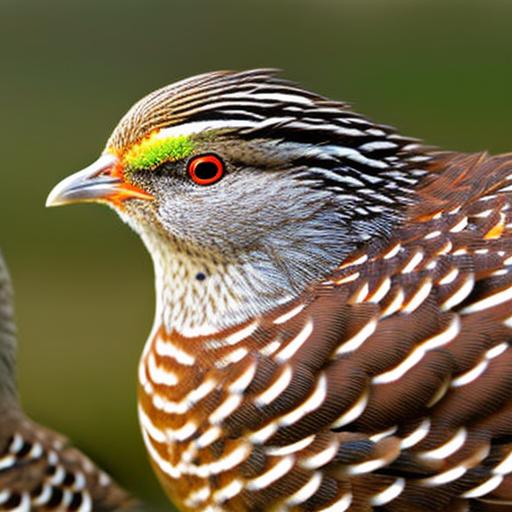Keeping quails with chickens can be a rewarding and beneficial practice for poultry enthusiasts. Quails and chickens have different characteristics and needs, but with proper planning and management, they can coexist harmoniously in the same coop. This article will provide a comprehensive guide to understanding the differences between quails and chickens, factors to consider before keeping them together, tips for introducing quails to an existing chicken flock, managing the coop and nesting areas, and the potential benefits and drawbacks of keeping quails with chickens. By the end of this article, readers will have a thorough understanding of how to successfully integrate quails into a chicken flock and maximize the benefits of this combined poultry setup.
Key Takeaways
- Keeping quails with chickens can be a rewarding experience, but it requires careful consideration and planning.
- Understanding the differences between quails and chickens, such as their size, behavior, and dietary needs, is crucial for successful cohabitation.
- Factors to consider before keeping quails with chickens include space requirements, predator protection, and potential health risks.
- When introducing quails to an existing chicken flock, it’s important to do so gradually and monitor their interactions closely.
- Managing the coop and nesting areas for quails and chickens involves providing separate spaces and ensuring proper hygiene to prevent disease transmission.
Understanding the Differences Between Quails and Chickens
Quails and chickens are both popular choices for backyard poultry keeping, but they have distinct differences in terms of size, behavior, and egg production. Quails are much smaller than chickens, typically weighing around 4-6 ounces compared to the average chicken weight of 5-8 pounds. They are also more ground-dwelling birds, preferring to forage and nest on the ground rather than roosting in elevated areas like chickens. In terms of behavior, quails are known for being more skittish and flighty compared to the relatively docile nature of chickens. Additionally, quails are prolific layers, with some breeds laying up to 300 eggs per year, while chickens generally lay around 200-300 eggs annually. Understanding these differences is crucial for successfully integrating quails into a chicken flock, as it will inform decisions regarding housing, feeding, and overall management of the combined poultry setup.
On the other hand, chickens are larger and more social birds that are known for their ability to form strong social hierarchies within a flock. They are also more adaptable to various housing setups, including traditional coops with roosting bars and nesting boxes. Chickens are also known for their diverse egg colors and sizes, making them a popular choice for egg production in backyard settings. Understanding these differences is essential for creating a suitable environment that meets the needs of both quails and chickens when kept together. By recognizing their unique characteristics, poultry keepers can ensure that both species thrive in a shared living space.
Factors to Consider Before Keeping Quails with Chickens
Before integrating quails into an existing chicken flock, there are several important factors to consider to ensure the well-being of both species. Firstly, it is crucial to assess the available space in the coop and outdoor run to determine if there is enough room to accommodate both quails and chickens comfortably. Quails require less space compared to chickens, but they still need ample room to forage, dust bathe, and establish their own territories within the shared environment. Additionally, it is important to consider the compatibility of different breeds within the flock, as some chicken breeds may be more aggressive towards quails or vice versa. Understanding the social dynamics and pecking order within the flock is essential for preventing conflicts and ensuring a harmonious coexistence between quails and chickens.
Another factor to consider is the dietary requirements of quails and chickens. While both species can consume commercial poultry feed, quails have specific nutritional needs that may require supplementation with higher protein levels, especially during egg production. It is important to provide separate feeding stations for quails to ensure they have access to their specialized diet without competition from chickens. Additionally, providing adequate access to water is crucial, as quails have a higher water intake compared to chickens due to their smaller size and higher metabolic rate. By considering these factors before integrating quails with chickens, poultry keepers can create a conducive environment that promotes the health and well-being of both species.
Tips for Introducing Quails to an Existing Chicken Flock
Introducing quails to an existing chicken flock requires careful planning and gradual integration to minimize stress and potential conflicts between the two species. One effective approach is to introduce juvenile quails to the chicken flock, as they are less likely to pose a threat to established adult chickens. By raising quail chicks alongside young chickens, they can become accustomed to each other’s presence and develop social bonds from an early age. This can help facilitate a smoother integration process when the quails reach maturity and are fully introduced to the adult chicken flock.
Another tip is to provide separate living quarters within the coop initially, allowing quails and chickens to become familiar with each other’s presence without direct physical contact. This can be achieved by using wire partitions or dividers to create distinct areas for quails and chickens while still allowing visual and auditory interaction between the two groups. Over time, as they become more accustomed to each other’s presence, the partitions can be gradually removed to allow for closer proximity and eventual cohabitation within the same living space.
Additionally, it is important to monitor the behavior of both quails and chickens during the integration process and intervene if any aggressive behavior or bullying is observed. Providing multiple feeding and watering stations can help minimize competition for resources and reduce potential conflicts within the flock. By following these tips for introducing quails to an existing chicken flock, poultry keepers can promote a smooth transition and foster positive interactions between the two species.
Managing the Coop and Nesting Areas for Quails and Chickens
Managing the coop and nesting areas is essential for creating a suitable living environment that meets the needs of both quails and chickens. When housing quails with chickens, it is important to provide separate nesting areas for each species to prevent competition for nesting space. Quails prefer to lay their eggs in secluded ground-level nests with ample bedding material, while chickens typically use elevated nesting boxes within the coop. By providing distinct nesting areas for quails and chickens, poultry keepers can ensure that both species have access to suitable nesting spaces without territorial conflicts.
In terms of coop management, it is important to provide adequate ventilation and lighting for both quails and chickens. Proper ventilation helps maintain air quality within the coop and prevents moisture buildup, which can lead to respiratory issues in poultry. Additionally, providing natural or artificial lighting can help regulate egg production in both quails and chickens, especially during the winter months when daylight hours are reduced. By managing these environmental factors within the coop, poultry keepers can create a comfortable and conducive living space for both quails and chickens.
Furthermore, managing the outdoor run or free-ranging area is important for allowing quails and chickens to engage in natural behaviors such as foraging, dust bathing, and socializing. Providing ample space for both species to roam and explore can help reduce stress and behavioral issues within the flock. Additionally, incorporating natural elements such as perches, shrubs, and hiding spots can enrich the outdoor environment and provide opportunities for both quails and chickens to exhibit their natural behaviors. By effectively managing the coop and outdoor areas, poultry keepers can create a harmonious living environment that promotes the well-being of both quails and chickens.
Potential Benefits and Drawbacks of Keeping Quails with Chickens

Keeping quails with chickens offers several potential benefits, including increased egg production, pest control, and diversified poultry products. Quails are prolific layers, often outperforming chickens in terms of egg production, which can contribute to a higher overall egg yield within the combined flock. Additionally, quail eggs are smaller in size but have a rich flavor profile, making them a desirable addition to a poultry keeper’s product offerings. By integrating quails into a chicken flock, poultry enthusiasts can diversify their egg production and offer unique quail eggs as part of their farm or homestead products.
Another potential benefit of keeping quails with chickens is pest control through foraging behavior. Quails are efficient ground foragers that consume insects, grubs, and small pests as part of their natural diet. By allowing quails to forage alongside chickens in outdoor areas, poultry keepers can harness their natural pest control abilities to reduce pest populations within the surrounding environment. This can contribute to a healthier ecosystem within the poultry setup and minimize reliance on chemical pest control methods.
However, there are also potential drawbacks to consider when keeping quails with chickens. One challenge is managing potential aggression or territorial behavior between quails and chickens, especially during the integration process or when establishing social hierarchies within the combined flock. Additionally, providing separate feeding stations and monitoring dietary intake is crucial to ensure that both species receive adequate nutrition without competition or resource guarding behaviors. By weighing these potential benefits and drawbacks, poultry keepers can make informed decisions about integrating quails into an existing chicken flock.
Conclusion and Final Considerations for Keeping Quails with Chickens
In conclusion, keeping quails with chickens can be a rewarding endeavor that offers various benefits in terms of egg production, pest control, and diversified poultry products. By understanding the differences between quails and chickens, considering important factors before integration, following tips for introducing quails to an existing chicken flock, managing coop and nesting areas effectively, and weighing potential benefits and drawbacks, poultry keepers can create a harmonious living environment that promotes the well-being of both species.
Before embarking on this poultry-keeping venture, it is important for poultry enthusiasts to conduct thorough research on the specific needs of quails and chickens, as well as local regulations or restrictions related to keeping these birds on their property. Additionally, seeking advice from experienced poultry keepers or consulting with veterinarians specializing in avian care can provide valuable insights into successful integration strategies and ongoing management practices.
Ultimately, by approaching the integration of quails with chickens with careful planning, patience, and a commitment to meeting the unique needs of both species, poultry keepers can create a thriving multi-species flock that offers diverse benefits and enriches their overall poultry-keeping experience.
If you’re considering keeping quails with chickens, it’s important to understand the compatibility and potential challenges of housing these two bird species together. To ensure the well-being of both quails and chickens, it’s crucial to provide appropriate housing and consider their dietary needs. For more insights on the dietary requirements of poultry, check out this informative article on what to feed ducks. Understanding the nutritional needs of different poultry species can help you create a harmonious environment for your birds.
FAQs
Can you keep quails with chickens?
Yes, it is possible to keep quails with chickens in the same coop or enclosure.
What are the benefits of keeping quails with chickens?
Keeping quails with chickens can provide a diverse and dynamic flock, as well as potential pest control benefits.
Are there any potential issues with keeping quails with chickens?
There may be potential issues with aggression between the quails and chickens, as well as differences in dietary needs.
How can I ensure the well-being of both quails and chickens in the same enclosure?
Providing ample space, separate feeding areas, and monitoring for any signs of aggression or stress can help ensure the well-being of both quails and chickens in the same enclosure.
What should I consider before keeping quails with chickens?
Before keeping quails with chickens, it is important to consider the space requirements, potential for aggression, and the specific needs of both quails and chickens.
Meet Walter, the feathered-friend fanatic of Florida! Nestled in the sunshine state, Walter struts through life with his feathered companions, clucking his way to happiness. With a coop that’s fancier than a five-star hotel, he’s the Don Juan of the chicken world. When he’s not teaching his hens to do the cha-cha, you’ll find him in a heated debate with his prized rooster, Sir Clucks-a-Lot. Walter’s poultry passion is no yolk; he’s the sunny-side-up guy you never knew you needed in your flock of friends!







